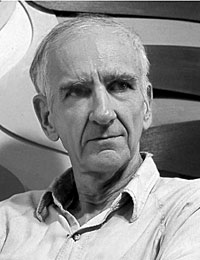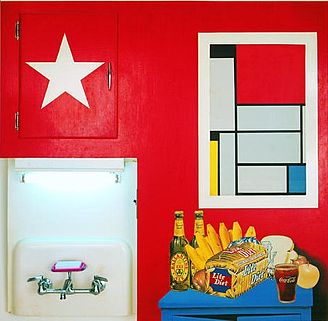| Tom Wesselmann | |
|---|---|
 |
|
| Born | Feb. 23, 1931 Cincinnati, Ohio |
| Died | Dec. 17, 2004 (at age 73) |
| Nationality | American |
| Movement | Pop art |
| Field | Painting, Collage, Sculpture, assemblage |
| Works | View Most Works |
Tom Wesselmann (1931-2004) was an artist whose works centered about the Pop art category. He worked in sculpture, painting and collage.
College Life and Early Progress in Career
Between 1949 and 1951, he went to college in Ohio. He began at Hiram College before transferring to the University of Cincinnati where he majored in Psychology. In 1952, he was recruited into the United States Army though most of his service years were spent at stateside.
It is at this time that he created his first cartoons, a move that ignited in him a passion to pursue the cartooning career. After being discharged, he went to wind up his degree program in psychology in 1954. It is at this time that he started to study drawing. He made some early progress after selling his very first cartoon strips to the True and 1000 Jokes magazines.
In 1956, Tom was accepted by Cooper Union while he went on with his studies. After visiting MoMA, he got his first inspiration from the painting by Robert Motherwell. This was really exciting just before Willem de Kooning’s work struck his attention. However, Tom soon turned down action painting and decided to follow his own passion.
In 1957, he met Claire Selley, who was a Cooper Union student. Claire became his friend, model and ultimately, his life partner. The following year was a defining moment for Wesselmann. After going for a trip within rural New Jersey, he discovered his passion was more inclined towards painting rather than cartooning.
Exhibition of Collagen Works in the 60’s
After graduating, Wesselmann became one of Judson Gallery’s founders, alongside Jim Dine and Marc Ratliff, who had just come to New York from Cincinnati. He and Ratliff took part in an exhibition where they portrayed several small collages. He started teaching art in a public school at Brooklyn and then later at a high school specializing in art and design.

Still Life #20, mixed media, 1962,
Albright-Knox Art Gallery Buffalo, New York
He created the Great American Nude series of artworks that made him to be known in the art world. In this painting, he utilized white, red and blue colors in addition to other colors related to patriotic motifs like khaki and gold. The series integrated representational images comprised of the patriotic theme including portraits of some founding fathers as well the American landscape pictures.
The images were often collaged from discarded posters and magazines that required a bigger format than Tom Wesselmann (1931-2004) had utilized previously. When his works began to grow to greater scales, he started approaching the advertisers to be placed on billboards. At some point, Alex Katz took Wesselmann to the Tanager gallery show. Later during that year, he made his first solo show at the same venue. This show represented both the small and big collages of the Great American Nude.
In 1962, he was offered another solo exhibition that took place at the Green gallery. It was about this period that Ivan Karp from Leo Castelli Gallery introduced him to many other collectors. Wesselmann viewed all these works but failed to spot any similarities with his own works.
It is at this time that the phrase ‘America Pop Art’ became popular, though Wesselmann did not want to be associated with it. He pointed out that his works utilized all common objects and that the word Pop overemphasized the kind of material used.
In 1964, Tom was contacted by Ben Birillo and other fellow artists to help them organize for the American Supermarket. This was to occur in Bianchini gallery within New York. This required the installation of a huge supermarket in which Pop arts were exhibited in addition to neon and real food signs. It is during this year that Wesselmann started doing projects on landscapes such as one including the noise produced by a Volkswagen as it is starting up. It is also during this year that the shaped canvas nudes appeared.
His New Famous Series of Art Work
Most of his artwork, during this period, particularly the Great American Nude, reveals an accentuated and a more explicit sensuality as if to celebrate a newly discovered romantic fulfillment of his latest relationship. He did this without leaving out the landscapes. The compositional focus of his works became not only daring, but also of more specific details: the mouth series started in 1965 and the Seascapes commenced a year later. Two new subjects also came up: Smoker Study and Bedroom Painting, the former being derived from observing the Mouth series model. In 1970s, the Smoker Study became a key recurrent theme.
In 1965, the artist made in depth studies regarding seascapes in oil, while on vacation in Cape Cod. In his studio in New York, he managed to magnify them into large-format pieces of art. The series of views dubbed the Drop-Out series were designed from a negative space around the breast. One side of this image was framed by the torso and breast whilst the other two sides were formed by the leg and arm. This series of art works became one of the themes that recurred most in the 1970s. He began designing shaped canvases and majored on larger formats.
The Bedroom Painting series is among the pieces of work he kept doing consistently. In this series, there was a juxtaposition of the elements of the Seascapes, Great American Nude and the Still Life. With these works, he began focusing on certain details of a figure like the feet, hands and breasts, which were surrounded by objects and flowers.
Metal Work in the Last Phase of His Life
In 1980, the artist published a monograph called Tom Wesselmann. Three years later, he became interested in making his drawings in steel. This made the drawings seem like they were lifted from a paper and placed over a wall. He further developed the idea of negative space that had earlier been used in Drop-Out series. These works began in black and white and eventually became colored. In addition to the colored metal nudes, he began working on landscape sketches which he magnified and fabricated into aluminum.
In the 1990s, his metalwork kept going through a perpetual metamorphosis. The Drawing Society came up with a video showing the artist creating a model’s portrait in aluminum. In the last decade of his life, Wesselmann’s health deteriorated because of a heart disease. However, his studio work went on constantly. After undergoing a surgical procedure for his heart problem, Tom Wesselmann passed away in 2004.